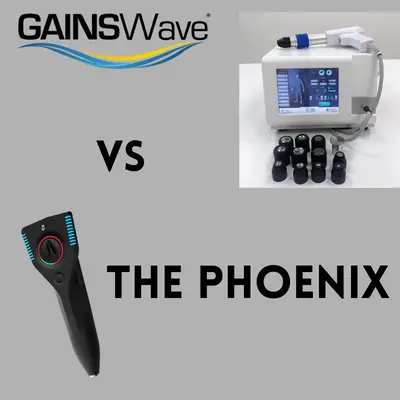GAINSwave vs Phoenix plays second fiddle to the dreaded term of lack of performance in the bedroom. Of course, using one of these devices will go a long way towards addressing this issue. It’s one of the last things in the world that any man wants to go through.
Unfortunately, bedroom performance affects over 30 million men in the United States alone. Considering the fact that men make up roughly half a population of 330 million or so, that means 18% of men will have to deal with it at some point.
Low-intensity shockwave therapy is the key to both devices, but which is the best choice? When dealing with this very sensitive issue, men don’t want second-best. They want the best treatment available. With shockwave therapy devices flooding the market, these two stand out in a crowded field.
GAINSwave and Phoenix Device Overview
Low-intensity shockwave therapy works by doing three things—facilitating the growth of new blood vessels, improving blood flow, and destroying micro plaque in existing blood vessels. Acoustic wave therapy is one of the few methods to treat erectile dysfunction that has no adverse side effects when used correctly.
GAINSwave
The GAINSwave is a medical-grade device that does exactly what’s listed above, improving poor blood flow and restoring erectile function. The shockwave therapy treatments are non-invasive and painless.
Each treatment session lasts between 20 and 30 minutes and can be performed in the privacy of your own home.
t’s easy to get caught up in the idea that sending shockwaves into your penis is a horrifying experience. Fortunately, technology renders those fears negligible, so long as you follow shockwave therapy protocols.
GAINSwave’s low-intensity shockwaves are what are known as elastic waves. These waves are targeted waves, not random. Theoretically, these waves can also induce new nerve tissue formation in the penis, on top of improved blood flow from new blood vessels.
Existing blood vessels are improved much in the same way that weightlifting grows muscle, especially with optimal nutrition and an established routine. The only drawback to GAINSwave is that it’s designed for use with your medical provider.
In other words, you have to set up appointments and receive GAINSwave treatments with a professional medical practitioner.
The Phoenix
The Phoenix is different from GAINSwave in that you don’t have to be at the doctor’s office to receive treatment. If you value privacy and want to do shockwave treatments at home The Phoenix is the obvious choice.
Like GAINSwave, a 6-treatment cycle is generally the magic number to reach before you start seeing results. Over time, the device will improve your erections making them stronger and last longer. Just because you don’t have to be in a clinic setting doesn’t mean the Phoenix isn’t a professional medical device.
It still uses powerful acoustic wave therapy to optimize existing blood vessels and reduce the issues that directly cause erectile dysfunction. There are a number of studies out there that show shockwave therapy from medical-grade shockwave devices combat erectile dysfunction.
The Phoenix device operates in much the same way as GAINSwave treatments, using a wand, with a water-based lubricant, to pass over and under the shaft of the penis to target the blood vessels and surrounding tissue.
GAINSwave: Risks, Costs, and Effectiveness
We know that shockwave therapy works for erectile dysfunction. But the cost is often a preventative issue, especially when you have to see the doctor for each treatment. As mentioned above, there are multiple studies that show shockwave therapy has a positive effect on ED without the side effects of other ED treatments.
A study in the World Journal of Urology, the National Library of Medicine, and a second, more involved study from the National Library of Medicine prove these positive effects of GAINSwave or shockwave therapy in general.
A medical professional conducts each therapy session, however, so you’re looking at a fairly steep cost at the end of each month. You don’t have to worry about the typical side effects of taking sildenafil or related ED medications. However, there are some side effects associated with wave therapy:
- Skin Bruising
- Painful erection
- Blood pooling under the skin
- Potential for infection
- Difficulty engaging in sexual activity
Fortunately, these side effects are exceedingly rare, most often caused by misuse or extensive use, something you don’t have to worry about in the presence of a doctor.
The Phoenix: Risks, Costs, and Effectiveness
The Phoenix device can be ordered and have delivered to your home. The upfront cost is much less then GAINSwave treatments in the office. The Phoenix is well under $1000 when you take advantage of my code OH365 at checkout. Get $85 off the device.
If there’s a drawback to using the Phoenix device for at-home shockwave therapy treatments it’s misuse from failing to follow the instructions to a T. The Phoenix is fairly simple to use and included are a thorough set of instructions on how and when to use shockwave therapy.
The Phoenix is a one-time price of $879. Once you purchase it, that’s it—you won’t have to spend any more for shockwave therapy treatments. However, the potential for the side effects listed above is more extensive because you are conducting your own treatments.
If you are too nervous to conduct the treatments yourself or have other sexual health concerns related to the Phoenix device, you should consult with your doctor before proceeding. Fortunately, the Phoenix is very easy to use and it will deliver adequate energy, resulting in increased blood flow and healthier blood vessels.
The Phoenix device comes with everything you need to get started, including medical guidance on the device and the treatment itself. Treating ED shouldn’t be a difficult concept and the Phoenix device keeps things as simple as possible.
Phoenix vs GAINSwave: Which One is Right for You?
Most people may not realize that GAINSwave and Phoenix are partners in the high-frequency acoustical waves treatment for the ED industry. The only, fundamental differences between the two are cost and convenience.
GAINSwave treatments are the same acoustic therapy treatments you get with the Phoenix device, they just require routine visits to the medical office and are more expensive in the long term. You’ll have to consult with a certified physician and receive treatments on a routine basis.
The Phoenix Pro device offers at-home treatments that are completely painless, surgery-free (GAINSwave is surgery-free as well), and treats ED, producing sustainable erections when you’re ready. The upfront cost for a Phoenix Pro device is substantial but it’s a one-and-done deal.
No matter which direction you choose to go, both have a proven track record of improving sexual difficulty in men. Shockwave technology is a growing sector in the men’s health industry and both Phoenix Pro devices and GAINSwave stands out as two of the more successful methods for treating ED through shockwave technology.
All Things Considered
Shockwave therapy is a proven treatment that will rehabilitate erectile tissue over time and with consistent use. Both GAINSwave and Phoenix Pro devices offer the same thing in different formats.
If you prefer to be heavily involved with your family physician and don’t like the idea of self-treatments, GAINSwave is probably the answer for you.
If you like the idea of using the Phoenix Pro on yourself and feel like you can establish a solid routine, the Phoenix Pro device is an excellent choice.
Either way, you’re taking the first steps toward improving your sex life and retaining the confidence you deserve. Both methods are secure, safe, tested, and proven to optimize shockwave therapy protocols





2 responses to “GAINSwave vs. The Phoenix: What is the Difference?”
[…] Phoenix Pro is like the GAINSWave. The GAINSWave is the medical device used for in-clinic treatments of erectile dysfunction. Both […]
[…] is not the only shockwave therapy men can choose to treat their ED. Other devices, such as the Phoenix Acoustic Wave Device can help men get an erection as effectively as GAINSWave at a lower […]